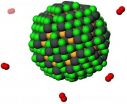(Press-News.org) Since the early 1970s, lithium has been the most popular element for batteries: it's the lightest of all metals and has the greatest electrochemical potential.
But a lithium-based battery has a major disadvantage: it's highly flammable, and when it overheats, it can burst into flames. For years, scientists have searched for safer battery materials that still have the same advantages as lithium. While plastics (or polymers) seemed like an obvious choice, researchers never fully understood how the material would change when an ion charge was introduced.
Now a Northwestern University team has married two traditional theories in materials science that can explain how the charge dictates the structure of the material. This opens the door for many applications, including a new class of batteries.
"There is a huge effort to go beyond lithium in a flammable solvent," says Monica Olvera de la Cruz, Lawyer Taylor Professor of Materials Science and Engineering at Northwestern and senior author of the paper. "People have been looking at alternatives that are not explosive, like plastics. But they didn't know how to compute what happens when you put in a charge."
Their paper, titled "Electrostatic control of block copolymer morphology," was published in the June 8 issue of Nature Materials.
The team looked at plastics known as block copolymers (BCPs) that are two types of polymers stuck together. They are a leading material for use as ion conductors because they self-assemble into nanostructures that both enable ion charge transport and maintain structural integrity. BCPs innately have nano-channels through which the ion can travel, but the charges themselves manipulate the shape of the channels. To use the material in batteries, researchers must find a way to control the shape of the nano-channels, so that the charge moves well.
"If you can optimize the ability of the charge to move through the system, then you can optimize the power that actually comes out of the battery," says Charles Sing, a postdoctoral fellow in Olvera de la Cruz's lab and first author of the paper.
The problem lies in the structure of the material. BCPs are very long chains of molecules. When they are stretched out, they extend over distances much greater than the typical size of the ion charges. However, the charges still have a strong effect on the nano-channels despite being much smaller. To properly understand the dynamics of BCPs, different theories are needed for the different length scales.
To understand how the ion charge changes the structure of the BCPs' nano-channels, Sing and Jos Zwanikken, a research assistant professor in the same lab, combined two traditional theories: the Self-Consistent Field Theory and Liquid State Theory. Self-Consistent Field Theory describes how long molecules behave.
"Liquid State Theory, on the other hand, describes how charges operate on very local, atomic levels," Zwanikken says.
While these two theories have been studied, in-depth, for decades, no one has previously put them together. When combined, they provide a new way of looking at the nano-channel systems. The electrical charge, known as an ion, is associated with an oppositely charged molecule, known as a counter-ion, which is also present in the nano-channel. Together, these ions and counter-ions are highly attracted to each other and form a salt. These salts cluster into miniature crystals, which exert a force on the nano-channels, changing their structure.
Olvera de la Cruz and her group found that these two effects balance one another—the salts want to form mini-crystals, which forces the nano-channel to deform. This understanding makes it possible to predict and even design a "highway system" through which the ions are transported, maximizing the power of the battery.
The team hopes their finding will guide experimentalists as they test materials. It will give researchers more information about the physical concepts underlying BCP systems.
Olvera de la Cruz says, “We have provided the tools to understand these systems by including ionic-length scale effects into the polymer mesoscale morphology."
INFORMATION:
This work was supported by the National Science Foundation, International Institute of Nanotechnology, Air Force Office of Scientific Research, and Office of the Director of Defense Research and Engineering.
Designing ion 'highway systems' for batteries
A Northwestern University team advanced the understanding of plastics for battery application
2014-06-09
ELSE PRESS RELEASES FROM THIS DATE:
CU researchers explain mechanism that helps viruses spread
2014-06-09
AURORA, Colo. (June 9, 2014) – In an article published in the scientific journal Nature, a University of Colorado School of Medicine researcher and colleagues explain how RNA molecules found in certain viruses mimic the shape of other molecules as part of a strategy to 'hijack' the cell and make more viruses.
The findings by Jeffrey S. Kieft, PhD, associate professor of biochemistry and molecular genetics at the School of Medicine and an early career scientist with the Howard Hughes Medical Institute, and his colleagues solve a biochemical and molecular mystery that has ...
Satellite sees System 90L dissipating over Mexico
2014-06-09
NASA and NOAA satellites are gathering visible, infrared, microwave and radar data on a persistent tropical low pressure area in the southwestern Bay of Campeche. System 90L now has a 50 percent chance for development, according to the National Hurricane Center and continues to drop large amounts of rainfall over southeastern Mexico.
The Atmospheric Infrared Sounder (AIRS) instrument aboard NASA's Aqua satellite gathered infrared data on the developing low on June 5 at 18:59 UTC (2:59 p.m. EDT).
Basically, AIRS looks at the infrared region of the spectrum. In a spectrum, ...
Scientists may have identified echoes of ancient Earth
2014-06-09
A group of scientists believe that a previously unexplained isotopic ratio from deep within the Earth may be a signal from material from the time before the Earth collided with another planet-sized body, leading to the creation of the Moon. This may represent the echoes of the ancient Earth, which existed prior to the proposed collision 4.5 billion years ago. This work is being presented at the Goldschmidt conference in Sacramento, California.
The currently favoured theory says that the Moon was formed 4.5 billion years ago, when the Earth collided with a Mars-sized mass, ...
Surgery prices are elusive
2014-06-09
Let's say you're buying a car. You have a wealth of data at your fingertips, from safety information to performance, to guide your decision.
The same is not as true in health care, especially if you're pricing procedures. A new study from the University of Iowa compared the cost of prostate cancer surgery at 100 hospitals throughout the United States. The quote for the procedure, the researchers found, varied from $10,100 to $135,000, a 13-fold range. (The average price was nearly $35,000, more than double the Medicare reimbursement.)
Only 10 of the hospitals that provided ...
New class of nanoparticle brings cheaper, lighter solar cells outdoors
2014-06-09
TORONTO, ON — Think those flat, glassy solar panels on your neighbour's roof are the pinnacle of solar technology? Think again.
Researchers in the University of Toronto's Edward S. Rogers Sr. Department of Electrical & Computer Engineering have designed and tested a new class of solar-sensitive nanoparticle that outshines the current state of the art employing this new class of technology.
This new form of solid, stable light-sensitive nanoparticles, called colloidal quantum dots, could lead to cheaper and more flexible solar cells, as well as better gas sensors, infrared ...
With distance comes greater wisdom, research finds
2014-06-09
If you're faced with a troubling personal dilemma, such as a cheating spouse, you are more likely to think wisely about it if you consider it as an observer would, says a study led by a professor at the University of Waterloo.
Professor Igor Grossmann, of Waterloo, and Professor Ethan Kross from the University of Michigan, asked study participants to reflect on a relationship conflict of their own or someone else's, such as a spouse's infidelity with a close friend, and think about the conflict in the first and third person. The findings will appear in an upcoming issue ...
Online marketing schemes can still lure in customers
2014-06-09
Despite warnings and legislation, online consumers may still be susceptible to post-transaction marketing schemes, according to Penn State researchers.
At least 40 percent of consumers who made an online purchase in a study bought an additional product, even though it offered no extra value, said Jens Grossklags, assistant professor of information sciences and technology.
"The focus of this study was to determine the likelihood that a consumer would accept an offer after they had already made a purchase," said Grossklags. "What stood out was the vast number of people ...
Seeing how a lithium-ion battery works
2014-06-09
CAMBRIDGE, Mass-- New observations by researchers at MIT have revealed the inner workings of a type of electrode widely used in lithium-ion batteries. The new findings explain the unexpectedly high power and long cycle life of such batteries, the researchers say.
The findings appear in a paper in the journal Nano Letters co-authored by MIT postdoc Jun Jie Niu, research scientist Akihiro Kushima, professors Yet-Ming Chiang and Ju Li, and three others.
The electrode material studied, lithium iron phosphate (LiFePO4), is considered an especially promising material for ...
Science and technology advances in microbial forensics needed to better prepare
2014-06-09
WASHINGTON – Much as human DNA can be used as evidence in criminal trials, genetic information about microorganisms can be analyzed to identify pathogens or other biological agents in the event of a suspicious disease outbreak. The tools and methods used to investigate such outbreaks belong to an emerging discipline known as microbial forensics, but the field faces substantial scientific and technical challenges, says a new report from the National Research Council. The report offers an initial set of research priorities for advancing the capabilities needed to make microbial ...
Specific protein may help beta cells survive in type 1 diabetes
2014-06-09
In the healthy pancreas of someone without type 1 diabetes (T1D), the hormone insulin (essential for turning food into energy) is produced, stored, and released in a normal "factory-like" process within pancreatic beta cells in response to glucose in the diet. Early in the course of T1D, however, excessive or pathologic stress in beta cells compromises their ability to properly secrete insulin, triggering a cascade of events ultimately contributing to the beta cell death. Over the past several years, JDRF-funded researchers have found evidence that beta cell stress may ...
LAST 30 PRESS RELEASES:
Why nail-biting, procrastination and other self-sabotaging behaviors are rooted in survival instincts
Regional variations in mechanical properties of porcine leptomeninges
Artificial empathy in therapy and healthcare: advancements in interpersonal interaction technologies
Why some brains switch gears more efficiently than others
UVA’s Jundong Li wins ICDM’S 2025 Tao Li Award for data mining, machine learning
UVA’s low-power, high-performance computer power player Mircea Stan earns National Academy of Inventors fellowship
Not playing by the rules: USU researcher explores filamentous algae dynamics in rivers
Do our body clocks influence our risk of dementia?
Anthropologists offer new evidence of bipedalism in long-debated fossil discovery
Safer receipt paper from wood
Dosage-sensitive genes suggest no whole-genome duplications in ancestral angiosperm
First ancient human herpesvirus genomes document their deep history with humans
Why Some Bacteria Survive Antibiotics and How to Stop Them - New study reveals that bacteria can survive antibiotic treatment through two fundamentally different “shutdown modes”
UCLA study links scar healing to dangerous placenta condition
CHANGE-seq-BE finds off-target changes in the genome from base editors
The Journal of Nuclear Medicine Ahead-of-Print Tip Sheet: January 2, 2026
Delayed or absent first dose of measles, mumps, and rubella vaccination
Trends in US preterm birth rates by household income and race and ethnicity
Study identifies potential biomarker linked to progression and brain inflammation in multiple sclerosis
Many mothers in Norway do not show up for postnatal check-ups
Researchers want to find out why quick clay is so unstable
Superradiant spins show teamwork at the quantum scale
Cleveland Clinic Research links tumor bacteria to immunotherapy resistance in head and neck cancer
First Editorial of 2026: Resisting AI slop
Joint ground- and space-based observations reveal Saturn-mass rogue planet
Inheritable genetic variant offers protection against blood cancer risk and progression
Pigs settled Pacific islands alongside early human voyagers
A Coral reef’s daily pulse reshapes microbes in surrounding waters
EAST Tokamak experiments exceed plasma density limit, offering new approach to fusion ignition
Groundbreaking discovery reveals Africa’s oldest cremation pyre and complex ritual practices
[Press-News.org] Designing ion 'highway systems' for batteriesA Northwestern University team advanced the understanding of plastics for battery application


